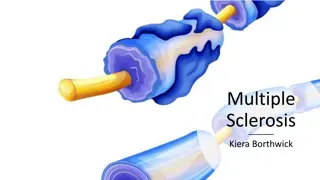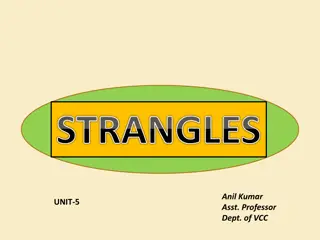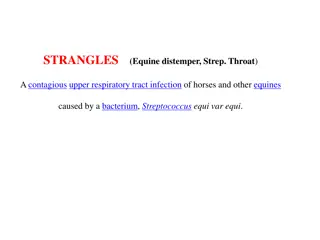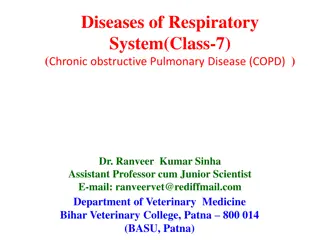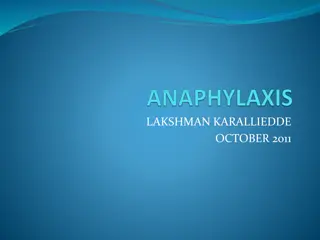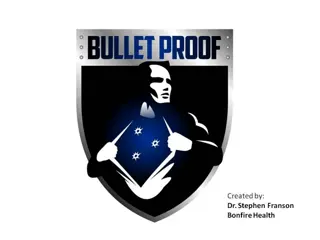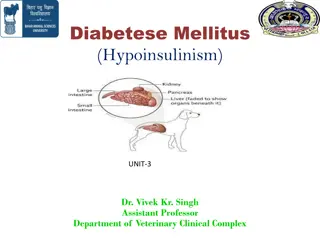Understanding Azoturia in Horses: Causes, Symptoms, and Treatment
Azoturia, also known as exertional rhabdomyolysis or tying-up syndrome, is a multifactorial myopathy that mainly affects draft horses. It is characterized by stiffness in gait, reluctance to move, lameness, and myoglobinuria. The disease typically occurs during exercise after a period of rest and can lead to muscle degeneration and swelling due to lactic acid accumulation. Clinical signs range from poor performance to severe sweating, muscle stiffness, and recumbency. Prompt diagnosis based on clinical signs and laboratory tests is crucial for effective treatment. Prognosis varies depending on the severity of the condition, with animals standing having a better outcome than those recumbent.
Download Presentation

Please find below an Image/Link to download the presentation.
The content on the website is provided AS IS for your information and personal use only. It may not be sold, licensed, or shared on other websites without obtaining consent from the author. Download presentation by click this link. If you encounter any issues during the download, it is possible that the publisher has removed the file from their server.
E N D
Presentation Transcript
AZOTURIA Dr Sonam Bhatt Asstt Prof Veterinary Medicine BVC, Basu
Exertional rhabdomyolysis Tying-up Cording-up Syndrome of Horses Paralytic myoglobinuria Monday Morning Disease
Multifactorial myopathy Mainly affects draft horses Metabolic muscular disorder of horses Clinically characterised by Stiffness in gait & reluctance to move Lameness Hardening of massive muscles In severe cases ----myoglobinuria
Disease occurs during exercise after a period of atleast 2 days of complete rest on a full working ration
PATHOGENESIS During exercise the large store of glycogen formed during the period of rest in the muscles metabolized to sarcolactic acid 2- Accumulation of lactic acid leads to: a- Degeneration of the muscles and liberation of myoglobin (muscle haemoglobin) b- Swelling of muscle because lactic acid is hydrophilic
CLINICAL SIGNS In very mild cases: only poor performance Mild cases: stiffness in gait Severe cases: Profuse sweating, stiffness in gait & reluctance to move Horse assumes a dog-sitting position followed by lateral recumbency, laying down & repeated attempts to rise, often with nervous signs
Rapid respiration, weak pulse & temp. may rise to 40.5 C Hard board like muscles particularly of hind legs Dark-red brown urine (myoglobinuria)
Red color urine Dog sitting posture Sweating
PROGNOSIS Good if animal remains standing Death occur in recumbent horse due to decubital septicemia or myoglobinuric nephrosis & uraemia
DIAGNOSIS History 1. Clinical signs 2. Laboratory diagnosis: 3. Determination of muscle specific enzymes CPK & AST Histopathology: Hyaline degeneration of heavy muscles (Zenker s necrosis), myonecrosis
TREATMENT Animal should be kept as quiet as possible, and attempts should be made to keep it standing Good nursing care & precautions taken to prevent development of decubital ulcers Nervous, restless animals, or those showing evidence of pain, should be given sedatives such as chloral hydrate or tranquilizers
Give Na bicarbonate IV or orally for alkalization of urine to minimise nephrotoxicity I/V injection of large quantities of fluids and electrolytes to maintain high rate of urine flow to avoid renal tubule blockage and subsequent uraemia I/M injection Thiamine daily to increase the tolerance of blood to lactic acid by increasing lactic acid metabolism
NSAIDs such as Flunixin and Phenylbutazone may be used to control the pain Antihistaminics, Vit. E & selenium may be useful





